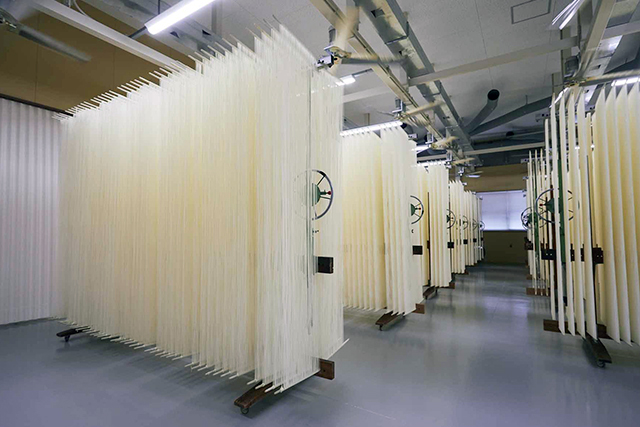Manufacturing Process

How Ibonoito Tenobe Somen is Made
Ibonoito Somen is manufactured during a limited period between October and the following April (production peaks from December to February).
Salted water is added to flour and then kneaded well to create the dough. The dough is then stretched carefully to make one long strip of Somen. This is the traditional hand-stretching technique that originated in the Banshu area some six hundred years ago.
The dough may separate if it is forcibly stretched out to quickly make it thin. Instead, it should be stretched out as much as possible while being twisted. After it is left to ripen it is stretched out again.
This process of ripening and stretching is repeated several times to make Somen. The entire process consists of eleven steps.
- 1. Pre-Kneading
-


Before kneading the dough
Wheat flour, salt, and water are kneaded together to make the Somen dough.
- 2. Itagi
-



Step #1
The dough is shaped into a mentai noodle strip approximately 10cm wide and 5cm thick, and then coiled into a saitou (a kind of bucket).Step #2
Several mentai are fed into the roller in order to make them into one. Then several of these larger pieces are combined into one piece. Repeat this process.
- 3. Koyori (twisting)
-


Aburagaeshi (applying oil)
The noodle belt is fed into the roller in order to make it into a thinner noodle.
First ripening
After the oil is applied, the noodle is left to ripen. -


Hosome (1st thinning)
After two hours’ of ripening, the noodle is fed into the roller while being twisted, thinning it down to 12mm in diameter.Second ripening
This time the noodle is ripened for about an hour. -


Konashi (2nd thinning)
The noodle is then made thinner and longer, thinning it down to about 6mm in diameter.Third ripening
Approximately four hours.
- 4. Kakeba (hanging Somen from racks)
-



Using a machine called a kakeba-ki,
the noodles are hung from two bars forming a figure eight, and placed into a ripening box called an omo.Fourth ripening
The fourth ripening then begins.
- 5. Kobiki (gentle stretching)
-



Trial stretch
After an hour the noodles are taken out of the omo and then stretched out to about 50cm, depending on the progress in ripening and the weather as well.Kobiki
After the trial stretching, the tools are adjusted based on many years’ of experience in order to stretch the noodles efficiently.Fifth ripening
After the kobiki, the noodles are placed into the omo once more for another ripening.
- 6. Kowake (sorting)
-


Kowake
The noodles are taken out of the omo and stretched to about 1.3m long.
- 7. Kadoboshi (drying)
-






The noodles are allowed to dry while being further stretched with a tool called a hata.
Then they are stretched little by little to 1.6m and 2m long.
Experience is necessary to properly change the direction of hata according to the weather and how the wind is blowing, in order to make sure that they will be dried evenly.
- 8. Cutting
-



Cutting
The noodles are dried until the water content is reduced to roughly 12%, and then cut into the finished size.
- 9. Weighing, binding, boxing
-


Weighing, binding, boxing
Cut Somen is bound into 50g bundles and fed through a metal detector before they are packed.
- 10. Inspection
-



Product inspection
Somen is graded by qualified inspectors.
Ripening in the warehouse
- 11. Warehousing
-


Warehousing
Following inspection, Ibonoito Somen is left to its last ripening within the dedicated warehouse until it is to be shipped.